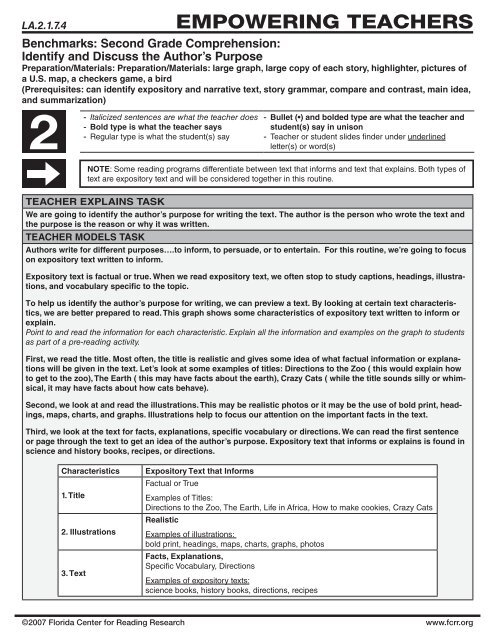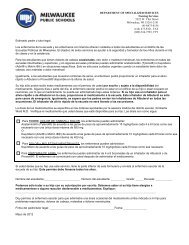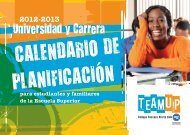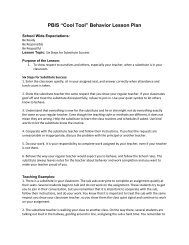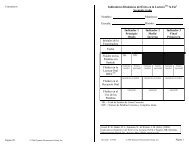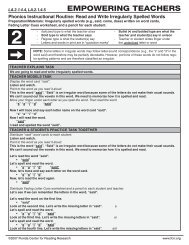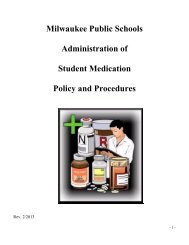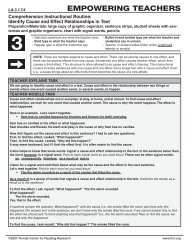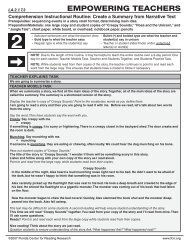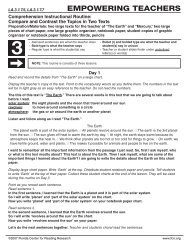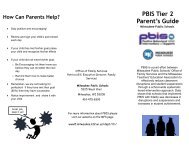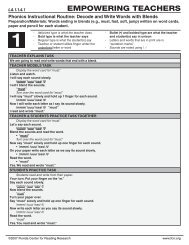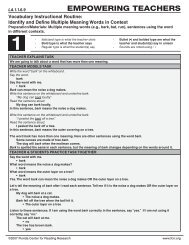Identify and Discuss the Author's Purpose
Identify and Discuss the Author's Purpose
Identify and Discuss the Author's Purpose
You also want an ePaper? Increase the reach of your titles
YUMPU automatically turns print PDFs into web optimized ePapers that Google loves.
LA.2.1.7.4<br />
EMPOWERING TEACHERS<br />
Benchmarks: Second Grade Comprehension:<br />
<strong>Identify</strong> <strong>and</strong> <strong>Discuss</strong> <strong>the</strong> Author’s <strong>Purpose</strong><br />
Preparation/Materials: Preparation/Materials: large graph, large copy of each story, highlighter, pictures of<br />
a U.S. map, a checkers game, a bird<br />
(Prerequisites: can identify expository <strong>and</strong> narrative text, story grammar, compare <strong>and</strong> contrast, main idea,<br />
<strong>and</strong> summarization)<br />
2<br />
-<br />
-<br />
-<br />
Italicized sentences are what <strong>the</strong> teacher does<br />
Bold type is what <strong>the</strong> teacher says<br />
Regular type is what <strong>the</strong> student(s) say<br />
-<br />
-<br />
Bullet (•) <strong>and</strong> bolded type are what <strong>the</strong> teacher <strong>and</strong><br />
student(s) say in unison<br />
Teacher or student slides finder under underlined<br />
letter(s) or word(s)<br />
NOTE: Some reading programs differentiate between text that informs <strong>and</strong> text that explains. Both types of<br />
text are expository text <strong>and</strong> will be considered toge<strong>the</strong>r in this routine.<br />
TEACHER EXPLAINS TASK<br />
We are going to identify <strong>the</strong> author’s purpose for writing <strong>the</strong> text. The author is <strong>the</strong> person who wrote <strong>the</strong> text <strong>and</strong><br />
<strong>the</strong> purpose is <strong>the</strong> reason or why it was written.<br />
TEACHER MODELS TASK<br />
Authors write for different purposes….to inform, to persuade, or to entertain. For this routine, we’re going to focus<br />
on expository text written to inform.<br />
Expository text is factual or true. When we read expository text, we often stop to study captions, headings, illustrations,<br />
<strong>and</strong> vocabulary specific to <strong>the</strong> topic.<br />
To help us identify <strong>the</strong> author’s purpose for writing, we can preview a text. By looking at certain text characteristics,<br />
we are better prepared to read. This graph shows some characteristics of expository text written to inform or<br />
explain.<br />
Point to <strong>and</strong> read <strong>the</strong> information for each characteristic. Explain all <strong>the</strong> information <strong>and</strong> examples on <strong>the</strong> graph to students<br />
as part of a pre-reading activity.<br />
First, we read <strong>the</strong> title. Most often, <strong>the</strong> title is realistic <strong>and</strong> gives some idea of what factual information or explanations<br />
will be given in <strong>the</strong> text. Let’s look at some examples of titles: Directions to <strong>the</strong> Zoo ( this would explain how<br />
to get to <strong>the</strong> zoo), The Earth ( this may have facts about <strong>the</strong> earth), Crazy Cats ( while <strong>the</strong> title sounds silly or whimsical,<br />
it may have facts about how cats behave).<br />
Second, we look at <strong>and</strong> read <strong>the</strong> illustrations. This may be realistic photos or it may be <strong>the</strong> use of bold print, headings,<br />
maps, charts, <strong>and</strong> graphs. Illustrations help to focus our attention on <strong>the</strong> important facts in <strong>the</strong> text.<br />
Third, we look at <strong>the</strong> text for facts, explanations, specific vocabulary or directions. We can read <strong>the</strong> first sentence<br />
or page through <strong>the</strong> text to get an idea of <strong>the</strong> author’s purpose. Expository text that informs or explains is found in<br />
science <strong>and</strong> history books, recipes, or directions.<br />
Characteristics<br />
1. Title<br />
2. Illustrations<br />
3. Text<br />
Expository Text that Informs<br />
Factual or True<br />
Examples of Titles:<br />
Directions to <strong>the</strong> Zoo, The Earth, Life in Africa, How to make cookies, Crazy Cats<br />
Realistic<br />
Examples of illustrations:<br />
bold print, headings, maps, charts, graphs, photos<br />
Facts, Explanations,<br />
Specific Vocabulary, Directions<br />
Examples of expository texts:<br />
science books, history books, directions, recipes<br />
©2007 Florida Center for Reading Research www.fcrr.org
TEACHER MODELS TASK (continued)<br />
EMPOWERING TEACHERS<br />
Now, I will use this graph to preview a paragraph about Florida. Then, I will read <strong>the</strong> entire text.<br />
Display “Florida”.<br />
Florida<br />
Florida became <strong>the</strong> 27th state in 1845. Florida is a state in <strong>the</strong> sou<strong>the</strong>rn part of <strong>the</strong> United States. The capital is<br />
Tallahassee. The state flower is <strong>the</strong> orange blossom. Many people come to live in Florida because of <strong>the</strong> warm<br />
wea<strong>the</strong>r <strong>and</strong> s<strong>and</strong>y beaches.<br />
Point to <strong>the</strong> title.<br />
The title is “Florida”. It is true; <strong>the</strong>re is a state called Florida.<br />
Point to <strong>the</strong> illustration.<br />
The illustration is a map of <strong>the</strong> US. It is realistic.<br />
Point to <strong>the</strong> text. Read <strong>the</strong> first sentence out loud.<br />
The content of this first sentence has facts about Florida.<br />
Point to some specific words in <strong>the</strong> paragraph (e.g., capital, state flower).<br />
In <strong>the</strong> rest of <strong>the</strong> paragraph, I see specific vocabulary about <strong>the</strong> state of Florida.<br />
Based on <strong>the</strong>se characteristics, I predict that <strong>the</strong> author’s purpose is to inform about <strong>the</strong> state of Florida. However,<br />
it is necessary to read <strong>the</strong> entire text in order to confirm or know <strong>the</strong> author’s purpose.<br />
Now I will read about Florida.<br />
Read <strong>and</strong> point to each word as you read “Florida” aloud.<br />
Based on what I just read about Florida, I can support my prediction that <strong>the</strong> author’s purpose was to inform. I do<br />
this by giving some facts from <strong>the</strong> text: <strong>the</strong> date it became part of <strong>the</strong> United States, <strong>the</strong> capital, <strong>the</strong> state flower, <strong>and</strong><br />
its climate. Underline or highlight <strong>the</strong>se facts in <strong>the</strong> text.<br />
This confirms my prediction that <strong>the</strong> author’s purpose is to inform about <strong>the</strong> state of Florida.<br />
When we can predict <strong>the</strong> author’s purpose for writing based on a few characteristics, we are better prepared to read<br />
<strong>and</strong> underst<strong>and</strong> <strong>the</strong> text.<br />
TEACHER AND STUDENTS PRACTICE TASK TOGETHER<br />
Let’s begin by reviewing. Authors write for different purposes….to inform, to persuade, or to entertain.<br />
What are <strong>the</strong> different purposes authors use to write<br />
• They write to inform, to persuade, or to entertain.<br />
I am going to read expository text written to inform.<br />
What type of text am I going to read<br />
• You are going to read expository text written to inform.<br />
Let’s look at our graph to review <strong>the</strong> characteristics of expository text that is written to inform. Refer to <strong>the</strong> large<br />
copy of <strong>the</strong> graph. Read <strong>and</strong> point to <strong>the</strong> information for each characteristic (e.g., title, illustrations, text). Then ask <strong>the</strong><br />
students to repeat it with you. Use <strong>the</strong> following pattern of review as an example.<br />
We know that <strong>the</strong> title is probably factual.<br />
What do we know about <strong>the</strong> title<br />
• The title is probably factual.<br />
Some examples of factual titles are: Directions to <strong>the</strong> Zoo <strong>and</strong> <strong>the</strong> Earth.<br />
What are some o<strong>the</strong>r examples of factual titles<br />
• Life in Africa, How to Make Cookies, Crazy Cats (accept new titles from students, if appropriate)<br />
Continue this way with Illustrations <strong>and</strong> Text.<br />
I am going to read a paragraph about “How to Play Checkers.” Before I begin to read, we will use <strong>the</strong> graph to<br />
preview <strong>the</strong> paragraph.<br />
Display “How to Play Checkers.”<br />
©2007 Florida Center for Reading Research www.fcrr.org
EMPOWERING TEACHERS<br />
TEACHER AND STUDENTS PRACTICE TASK TOGETHER (continued)<br />
How to Play Checkers<br />
The game of checkers is played with two players. There is a board with 32 dark <strong>and</strong> 32 light squares. Each player<br />
gets twelve game pieces. Players take turns moving diagonally on <strong>the</strong> dark squares. A player can capture an<br />
opponent’s piece by jumping over that piece. When <strong>the</strong> piece is captured, it is removed from <strong>the</strong> board. A player<br />
wins when <strong>the</strong> opponent cannot make a move or has lost all his pieces.<br />
Point to <strong>the</strong> title.<br />
The title is “How to Play Checkers.”<br />
What is <strong>the</strong> title<br />
• “How to Play Checkers”<br />
Point to <strong>the</strong> illustration.<br />
The illustration is a game of checkers. It is realistic.<br />
What is <strong>the</strong> illustration<br />
• The illustration is a game of checkers. It is realistic.<br />
Point to text. Read <strong>the</strong> first sentence out loud.<br />
The first sentence explains how many players can play checkers.<br />
What do we know about <strong>the</strong> first sentence<br />
• It explains how many people/players can play checkers.<br />
Point to <strong>and</strong> highlight some specific words in <strong>the</strong> paragraph (e.g., game board, squares).<br />
In <strong>the</strong> rest of <strong>the</strong> paragraph, I see specific vocabulary words about playing checkers. Here are <strong>the</strong> words, game<br />
board <strong>and</strong> squares. What are some specific vocabulary words about playing checkers<br />
• The words are game board <strong>and</strong> squares.<br />
Based on <strong>the</strong>se characteristics, we can predict that <strong>the</strong> author’s purpose is to explain how to play checkers.<br />
Based on <strong>the</strong>se characteristics, what can we predict<br />
• The author’s purpose is to explain how to play checkers.<br />
Now listen <strong>and</strong> follow along as I read aloud, “How to Play Checkers.” Point to each word as you read “How to Play<br />
Checkers” aloud.<br />
We can now support our prediction that <strong>the</strong> author’s purpose is to inform or explain. We do this by giving facts<br />
from <strong>the</strong> text. Underline or highlight <strong>the</strong>se facts in <strong>the</strong> text.<br />
How do we support our prediction<br />
• We give facts from <strong>the</strong> text.<br />
The facts are: 12 pieces, a game board, moving diagonally on dark squares.<br />
What are <strong>the</strong> facts<br />
• The facts are: 12 pieces, a game board, moving diagonally on dark squares.<br />
This confirms my prediction that <strong>the</strong> author’s purpose is to inform.<br />
Now it is your turn to identify <strong>the</strong> author’s purpose for writing.<br />
STUDENTS PRACTICE TASK<br />
Remember, authors write for different purposes…to inform, to persuade, or to entertain.<br />
What are <strong>the</strong> different purposes authors use to write<br />
They write to inform, to persuade, or to entertain.<br />
I am going to read expository text written to inform.<br />
What type of text am I going to read<br />
You are going to read expository text to inform.<br />
Yes. I am going to read a paragraph about birds. Before I begin to read, we are going to use <strong>the</strong> graph to preview<br />
<strong>the</strong> text. Display “Birds”.<br />
Birds<br />
Animals are divided into categories. They are grouped according to things <strong>the</strong>y have in common. One category<br />
is birds. All birds have fea<strong>the</strong>rs. They are warm-blooded. Birds lay eggs <strong>and</strong> <strong>the</strong>y have wings. Most birds fly, but<br />
<strong>the</strong>re are some that do not.<br />
©2007 Florida Center for Reading Research www.fcrr.org
STUDENTS PRACTICE TASK (continued)<br />
Point to <strong>the</strong> title.<br />
What is <strong>the</strong> title<br />
The title is “Birds”.<br />
Is this title probably factual<br />
Yes.<br />
EMPOWERING TEACHERS<br />
Point to <strong>and</strong> highlight some specific words in <strong>the</strong> paragraph (e.g., fea<strong>the</strong>rs, warm-blooded, lay eggs).<br />
In <strong>the</strong> rest of <strong>the</strong> paragraph, I see specific vocabulary words about birds. Read <strong>the</strong>se words with me:<br />
Fea<strong>the</strong>rs, warm-blooded, lay eggs, <strong>and</strong> wings.<br />
Based on <strong>the</strong>se characteristics, what can you predict about <strong>the</strong> author’s purpose<br />
The author’s purpose is to inform us about birds.<br />
Now I will read “Birds”. Read <strong>and</strong> point to each word as you read “Birds” aloud.<br />
Based on what I just read about birds, can you support your prediction that <strong>the</strong> author’s purpose is to inform using<br />
facts from <strong>the</strong> text<br />
Yes, we can support it.<br />
What facts can you give from <strong>the</strong> text<br />
Birds have fea<strong>the</strong>rs, <strong>the</strong>y are warm-blooded, <strong>the</strong>y have wings <strong>and</strong> lay eggs.<br />
Fantastic work. You did a nice job predicting <strong>the</strong> author’s purpose for writing a text based on a few characteristics.<br />
Thinking about <strong>the</strong>se characteristics prepared you for underst<strong>and</strong>ing <strong>the</strong> text <strong>and</strong> knowing why <strong>the</strong> author wrote it.<br />
INDEPENDENT PRACTICE<br />
When students consistently identify <strong>the</strong> author’s purpose in different texts, provide opportunities to practice individually or<br />
in pairs using examples of ‘text that informs’ or ‘text that entertains’. Call on students in an unpredictable order, calling more<br />
frequently on students who made errors.<br />
SCAFFOLDING SUGGESTION FOR ERRORS<br />
Verify that students are able to use <strong>the</strong> graph for initial characteristics during <strong>the</strong> pre-reading activity <strong>and</strong> correctly confirm<br />
<strong>the</strong>ir prediction after reading <strong>the</strong> text. Sometimes <strong>the</strong> author intentionally writes it to entertain <strong>and</strong> inform. When this occurs,<br />
it is important to explain this to students. If students are struggling with author’s purpose, it is important to know if <strong>the</strong>y<br />
have <strong>the</strong>se preskills: can identify expository from narrative text, fact from fiction, story grammar elements, main idea, <strong>and</strong><br />
summarization.<br />
Adaptations using this Instructional Routine:<br />
• If students are having difficulties with this routine, review <strong>the</strong> Empowering Teacher’s routines for story grammar,<br />
compare <strong>and</strong> contrast, main idea, <strong>and</strong> summarizing. Also review <strong>the</strong> concepts for fiction <strong>and</strong> nonfiction.<br />
• If students are not able to read <strong>the</strong> details on <strong>the</strong> graph during Student Practice Task, <strong>the</strong> teacher should read <strong>and</strong><br />
point to <strong>the</strong> details while <strong>the</strong> students look <strong>and</strong> listen.<br />
• Provide a highlighter for <strong>the</strong> teacher or students to mark <strong>the</strong> characteristics in <strong>the</strong> story. This could be <strong>the</strong> character,<br />
setting, problem <strong>and</strong> solution for ‘text that entertains’ <strong>and</strong> specific vocabulary or facts for ‘text that informs’.<br />
For fur<strong>the</strong>r independent practice, refer to <strong>the</strong> following Second <strong>and</strong> Third Grade FCRR Student Center Activities<br />
at http://www.fcrr.org/Curriculum/PDF/G2-3/2-3Comp_3.pdf<br />
• C.023 This activity also includes text that persuades so remove those cards.<br />
©2007 Florida Center for Reading Research www.fcrr.org
EMPOWERING TEACHERS<br />
Florida<br />
Florida became <strong>the</strong> 27th state in 1845. Florida is a state in <strong>the</strong><br />
sou<strong>the</strong>rn part of <strong>the</strong> United States. The capital is Tallahassee. The<br />
state flower is <strong>the</strong> orange blossom. Many people come to live in<br />
Florida because of <strong>the</strong> warm wea<strong>the</strong>r <strong>and</strong> s<strong>and</strong>y beaches.<br />
How to Play Checkers<br />
The game of checkers is played with two players. There is a board<br />
with 32 dark <strong>and</strong> 32 light squares. Each player gets twelve game<br />
pieces. Players take turns moving diagonally on <strong>the</strong> dark squares. A<br />
player can capture an opponent’s piece by jumping over that piece.<br />
When <strong>the</strong> piece is captured, it is removed from <strong>the</strong> board. A player<br />
wins when <strong>the</strong> opponent cannot make a move or has lost all his<br />
pieces.<br />
Birds<br />
Animals are divided into categories. They are grouped according to<br />
things <strong>the</strong>y have in common. One category is birds. All birds have<br />
fea<strong>the</strong>r. They are warm-blooded. Birds lay eggs <strong>and</strong> <strong>the</strong>y have wings.<br />
Most birds fly, but <strong>the</strong>re are some that do not.<br />
©2007 Florida Center for Reading Research www.fcrr.org
EMPOWERING TEACHERS<br />
©2007 Florida Center for Reading Research www.fcrr.org


